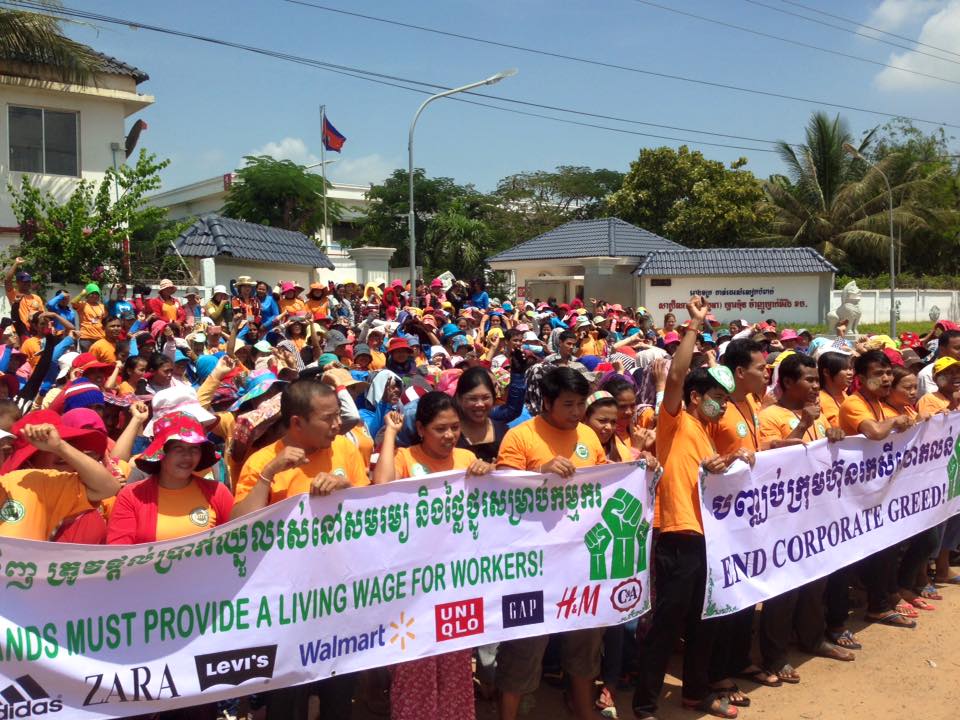
Oct 7, 2015
Some 21,000 garment workers from six unions at more than 60 factories across Cambodia dedicated their 30-minute lunch breaks to rallies calling for a higher minimum wage. The monthly minimum wage for garment and footwear workers is $128. Last year, Cambodia’s garment exports totaled $5.7 billion.
A recent study of garment workers and their expenditures, conducted by labor rights groups, including the Solidarity Center, indicates that the workers currently earn far less than they need to cover expenses.
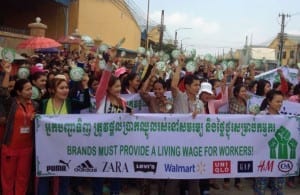
Garment workers from 60 factories around Cambodia devoted their 30-minute lunch breaks to rally on Decent Work Day. Credit: Solidarity Center/Khun Tharo
As part of the October 7 International Decent Work Day demonstrations around the theme, “End Corporate Greed,” workers from industrial areas in Phnom Penh, Sihanoukville, Kompong Spuer, Kandal and Svay Reing provinces held stickers and banners urging international brands to provide a decent living wage for Cambodian garment workers.
A working group of union representatives, employers and government officials has been meeting to determine a new 2016 minimum wage and are nearing a recommendation. The Coalition of Cambodian Apparel Workers Democratic Union (CCADWU) and other unions not affiliated with the government said that they will boycott the process if the recommendation does meet workers’ needs.
Over the past two years, tens of thousands of garment workers have taken to the streets in a series of strikes for minimum wage increases. In January 2014, Cambodian security forces shot into crowds of striking workers, killing at least five, injuring more than 60 and resulting in the arrests and dismissals of dozens of workers and union leaders.
Unions that took part in the Decent Work Day actions include the CCADWU, the Cambodian Alliance of Trade Unions, the Collective Union of Movement of Workers, the National Independent Federation of Textile Unions in Cambodia and Worker Freedom Union Federation.
The actions in Cambodia are part of worldwide activities around the world, with the International Trade Union Confederation reporting events in 33 countries at its World Day for Decent Work site.
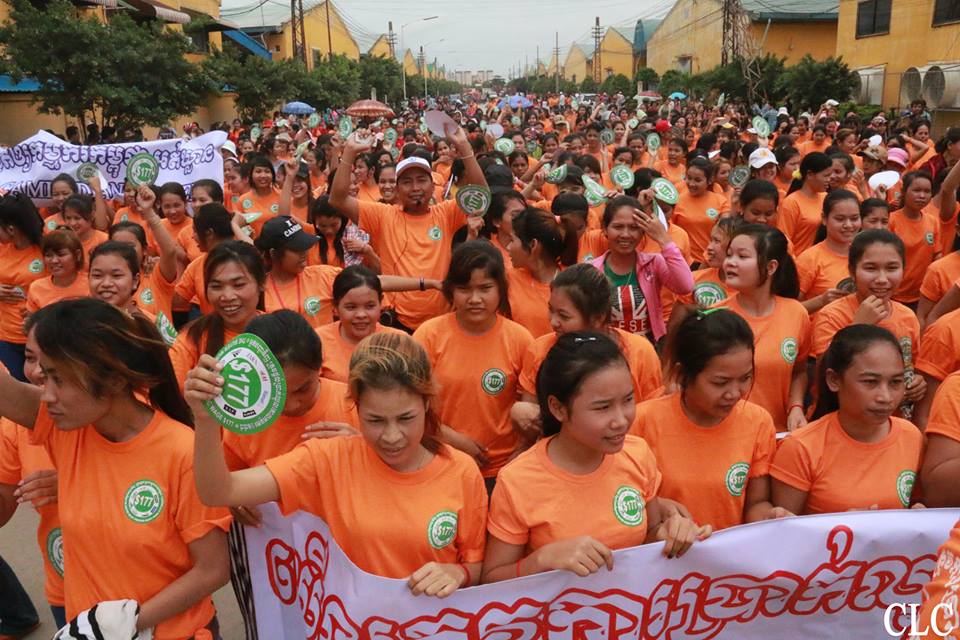
Nov 19, 2014
The Cambodian government announced in recent days it would raise the monthly minimum wage in the textile and apparel industry to $128, an amount workers say falls far short of the amount needed to support themselves and their families and is only $8 above the poverty line.
The new minimum wage also is well below the government’s estimates of wages garment workers need: Late last year, a government-appointed committee announced that a minimum living wage should be between $167 to $177 a month. The minimum wage for garment workers at the time was $80 a month, and even with the increase, Cambodia has among the lowest monthly minimum wage in the industry. Garment-making is Cambodia’s largest industry, accounting for 80 percent of exports.
Tens of thousands of garment workers, the majority of whom are women, have waged a series of mass protests over the past year, demanding a living wage. In January, Cambodian security forces shot into crowds of striking workers, killing at least five, injuring more than 60 and resulting in the arrests and dismissals of dozens of workers and union leaders.
In September, garment workers again took to the streets, demanding $177 per month and directing their protests at global clothing brands. Following the protests, a handful of global brands, including H&M and Zara, said they would pay more for clothing manufactured in Cambodia.
Some 90 percent of the country’s 600,000 garment workers have no permanent contracts and are instead employed under fixed-duration contracts. Without formal employment, workers on contract fear they will lose their jobs if they demand better working conditions. Garment workers on contract also are prevented from accruing seniority and related benefits, and women workers suffer discrimination when taking maternity leave or tending to other family-related duties.
Download the fact sheet, “Cambodia: The Garment Sector and Poverty Wages.”
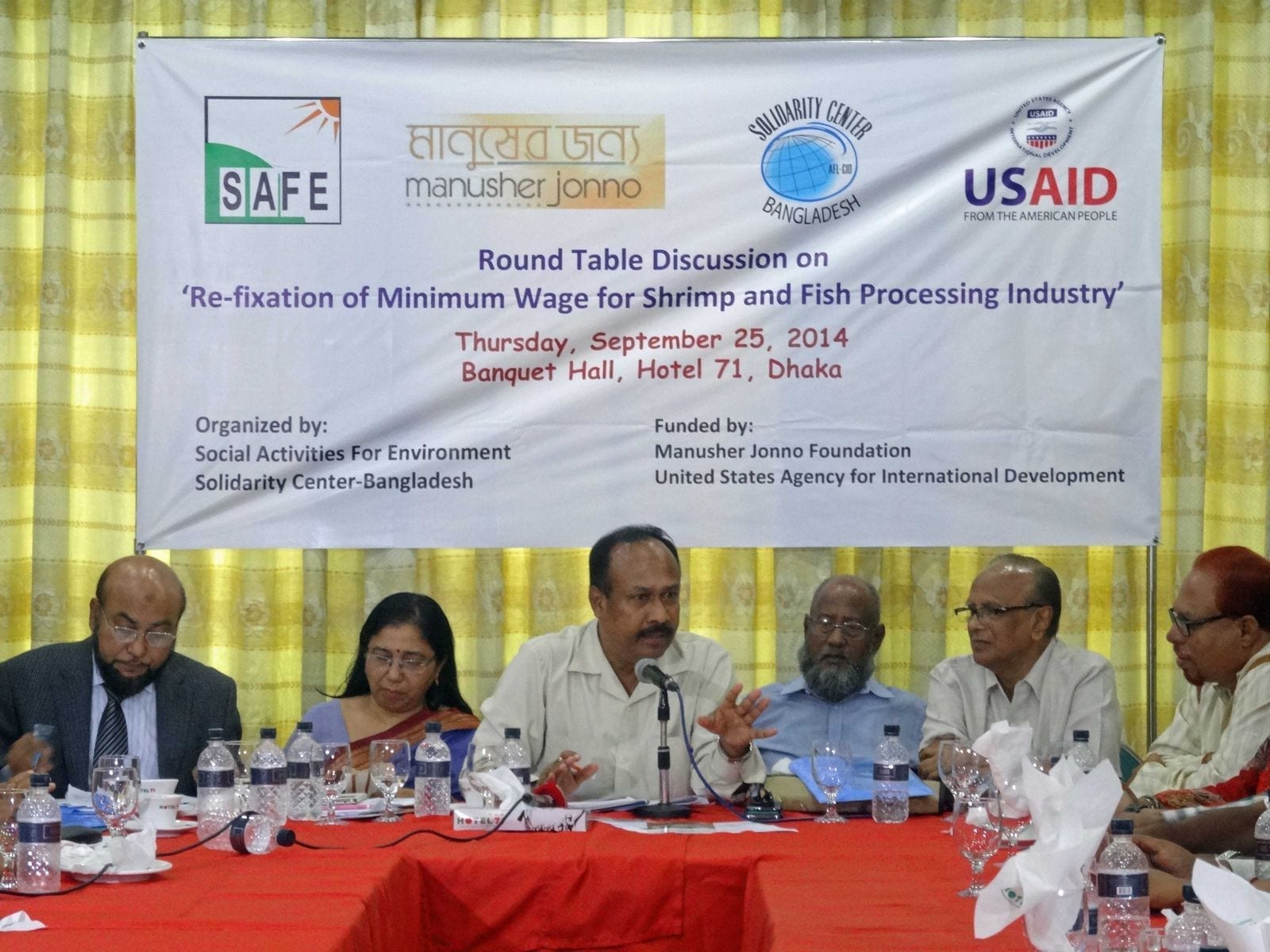
Sep 29, 2014
Mukta, who works in a shrimp factory in Khulna, Bangladesh, makes $50 per month but that wage is not enough to support his family.
“Although employers should raise wages every year according to the law, they don’t follow the rules,” he said. “I have worked in my factory for nine years and my salary has increased only once.”
Mukta joined a meeting on the wages in the shrimp and fish processing industry with representatives from labor, business and civil society last week. Organized by the Solidarity Center and Social Activities for the Environment (SAFE), the event in Dhaka, the capital, featured Md. Mujibul Haque Chunnu, state minister at the Ministry of Labor and Employment.
The government recently directed the Minimum Wage Board to reassess the minimum wage for workers in the shrimp and fish processing sector. The board, established in 2009, has not revisited the wage level since then.
“It has been five years since the minimum wage was reviewed in the sector,” said Solidarity Center Bangladesh Country Program Director Alonzo Suson. “Now is the time to move toward a new consensus for a living wage for workers in the shrimp industry. A new minimum wage level will not only benefit the workers but the entire community and can make good business sense for a more productive sector.”
Representatives from SAFE, the Bangladesh Frozen Foods Exporters Association (BFFEA) and an academic from Rajshahi University presented their analyses and recommendations based on current conditions and wage levels in the sector. Participant, including union leaders, members of parliament, employers and nongovernmental organizations, then engaged in a vigorous discussion.
Shaheen Anam, executive director of the Manusher Jonno Foundation, a human rights foundation that helped support the event along with U.S. Agency for International Development (USAID), noted the improved working conditions in the shrimp and fish processing sector which resulted from the work of “labor activists over the last several years.” But Anam pointed out that “these activists have faced a lot of threats … especially in the Khulna region.”
In 2013, the BFFEA, the Bangladesh Shrimp and Fish Foundation (BSFF) and the Solidarity Center signed a memorandum of agreement to implement worker rights according to Bangladesh labor law and International Labor Organization (ILO) core labor standards and to give workers the right to form trade unions.
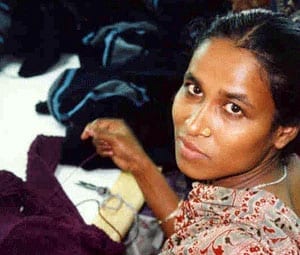
Sep 8, 2014
Garment workers at Chunji Knit Ltd., in Dhaka, Bangladesh, can now freely organize a union, and workers fired for union activity will be reinstated, according to a memorandum of understanding signed by Chunji management and the Bangladesh Federation of Workers Solidarity (BFWS).
The August 21 agreement follows a months-long struggle by workers to be paid the legal minimum wage and freely form a union. Workers protested in February after Chunji did not raise their wages in accordance with the country’s new $67 a month minimum wage for garment workers.
That same month, several union organizers and garment workers were physically attacked and beaten when talking with workers about forming a union. Two workers were hospitalized and some union supporters left the area for their personal safety.
The Wall Street Journal at the time quoted Shahnaz Begum, 25, a four-year Chunji factory worker, who said that factory managers had warned workers not to join the union before the incident in February.
Apr 17, 2014
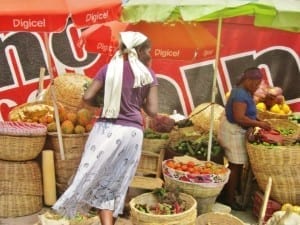
Despite rising exports, Haitian garment workers are paid so little they can barely afford food. Credit: Lauren Stewart
Despite a 45 percent increase in apparel exports since the 2010 earthquake in Haiti, the women and men who sew T-shirts and jeans primarily destined for the U.S. market barely earn enough to pay for their lunch and transportation to work, a new Solidarity Center survey finds.
The average cost of living for an export apparel worker in Port-au-Prince is 26,150 Haitian gourdes (about $607) per month. Yet workers are paid only between 200 gourdes (about $4.64) and 300 gourdes for an eight-hour day (about $6.96). After insurance and social security deductions, most export apparel workers must spend more than half of their salaries on transportation to and from the factory and a modest lunch, leaving little to sustain a family or keep a roof over their heads.
“Workers interviewed in this study had to forgo basic necessities given the disparity between their earned wages and the cost of living,” according to the report. “When asked what they would purchase if they had sufficient income, workers responded with: more food to feed their families, land to build a home, (and) a car or moped to drive their children to school.”
The Solidarity Center survey finds that a real living wage must be approximately 1,000 gourdes (about $23) per day to enable workers to meet basic needs. Haitian unions are demanding a minimum wage increase to at least 500 gourdes (about $11.60) per day and assert that anything lower equates to starvation wages. Despite the export industry’s growth, Haitian law mandates a reduced minimum wage for the sector, which is the lowest in the Western Hemisphere.
Housing (rental) costs spiked immediately after the earthquake, but prices have since fallen by nearly 28 percent. Yet workers still live in substandard housing and pay up to four times more than what they did prior to the disaster. Some families are unable to afford their children’s transportation to school, so many students must walk, sometimes long distances and along busy roads.
“The High Cost of Low Wages in Haiti” analyzed such expense categories as housing, energy, nutrition, clothing, health care, education and transportation to classify the costs of an export apparel worker. The report also includes charts breaking down each category of expense. It follows a similar informal study the Solidarity Center conducted after the earthquake and used the same locally appropriate basket of goods to calculate the cost of living for a three-member household, comprised of one adult wage earner and two minor dependents (ages 8–14).
The report concludes: “Workers need access to decent jobs that pay a living wage and allow them to lead a dignified life. So long as jobs perpetuate worker exploitation and serve only as a means to fend off starvation, poverty will continue to grip the country and hinder the reconstruction process.”
Read the full report.






